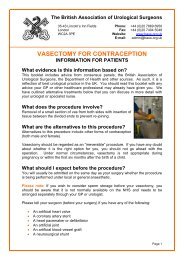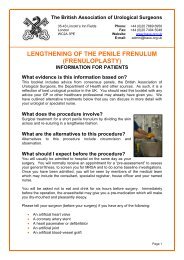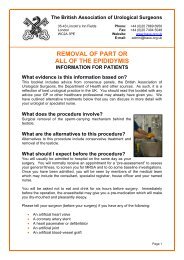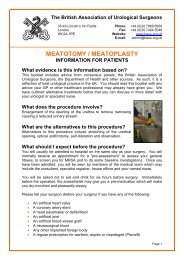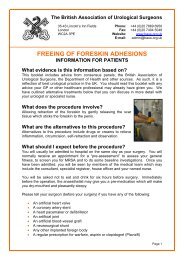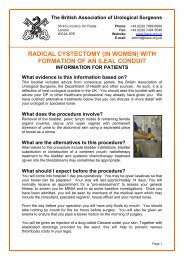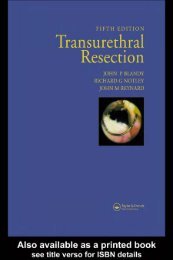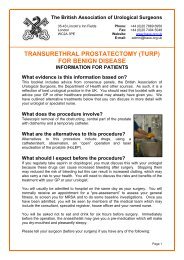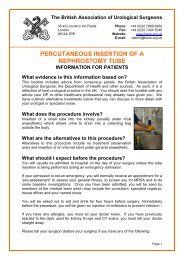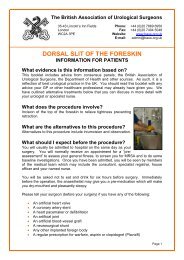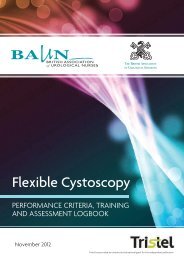MDT (multi-disciplinary team) guidance for managing prostate cancer
MDT (multi-disciplinary team) guidance for managing prostate cancer
MDT (multi-disciplinary team) guidance for managing prostate cancer
You also want an ePaper? Increase the reach of your titles
YUMPU automatically turns print PDFs into web optimized ePapers that Google loves.
Radical treatments<br />
Radical <strong>prostate</strong>ctomy<br />
There are now four approaches to per<strong>for</strong>ming a radical <strong>prostate</strong>ctomy: retropubic, perineal, laparoscopic<br />
and robotic. The procedure involves removal of the whole <strong>prostate</strong> and the seminal vesicles. The most<br />
commonly used approaches are retropubic and perineal, but laparoscopic and robotic techniques are<br />
becoming more frequently adopted. The newer approaches have the advantage of reduced blood loss<br />
and shorter inpatient stays.<br />
Overview<br />
• In 1997, Selley et al. reviewed a total of 17 studies (two randomised controlled trials [RCTs] and<br />
15 observational studies involving a total of 5410 patients) to investigate the efficacy of radical<br />
<strong>prostate</strong>ctomy <strong>for</strong> men with localised <strong>prostate</strong> <strong>cancer</strong>. Cancer-specific survival after 10 years of followup<br />
ranged from 86% to 91%, with clinical disease-free survival (DFS) ranging from 57% to 83%. 38<br />
Patient selection<br />
• Anaesthetic fitness<br />
• At least 10 years’ life expectancy<br />
• Complications increase and benefits decrease in patients aged >70 years<br />
Side-effects of treatment<br />
• Based on the systematic review by Selley et al., the following side-effects should be considered: 38<br />
o Operative and post-operative mortality: 0.2−1.2%<br />
o Sexual dysfunction: 51−61%<br />
o Incontinence (mild stress): 4−21%<br />
o Incontinence (total): 0−7%<br />
Clinical evidence<br />
• One randomised trial has compared radical <strong>prostate</strong>ctomy with watchful waiting in localised<br />
<strong>prostate</strong> <strong>cancer</strong>. 39<br />
o The trial randomised 695 men with localised disease between radical <strong>prostate</strong>ctomy and<br />
watchful waiting.<br />
o At a median follow-up of 8.2 years, randomisation to radical <strong>prostate</strong>ctomy was associated with<br />
a benefit both in terms of disease-specific mortality (hazard ratio [HR] 0.56; 95% confidence<br />
interval [CI]: 0.36−0.88; p=0.01) and overall mortality (HR 0.74; 95%CI: 0.56−0.99; p=0.04).<br />
o This translated into 10-year OS of 73% versus 68% (p=0.04) <strong>for</strong> radical <strong>prostate</strong>ctomy versus<br />
watchful waiting.<br />
o In terms of 10-year freedom from distant metastases, the absolute benefit of surgery versus<br />
watchful waiting was 10% (84.8% versus 74.6%; p=0.004).<br />
o However, patients need to weigh these benefits against the risk of adverse consequences of<br />
treatment. The 5% absolute improvement in 10-year survival was achieved at the expense of a<br />
35% absolute increase in the risk of erectile dysfunction and a 28% absolute increase in the risk<br />
of urinary leakage.<br />
22



